feature
Integrating the Five Practices and Model-Based Inquiry to Facilitate Meaningful Science Discourse
Using anchoring phenomena allows teachers to encourage students to think and act like scientists. Anchoring phenomena are observable events that can be explained or predicted by using science knowledge (NGSS Lead States, 2013) and provide a storyline around which students can construct and connect their ideas. This process engages and excites students, allowing them to bring their own life experiences and ideas to the table while working as scientists do. The end result is instruction in which students make sense of science ideas we are targeting.
This article demonstrates the use of a strategy called the Five Practices in facilitating goal-centered discussions in a model-based inquiry unit that foster the development of student ideas about an anchoring phenomenon. The learning and performance goals of the unit are summarized in Figure 1.
Learning goals and performance objectives
|
Learning goals |
Performance objective |
|
|
The anchoring phenomenon around which this unit is centered is hereafter referred to as the Magic Candle Demo and occurred on the first day of instruction. In this chemistry demonstration, the teacher showed the students a lit candle and a large empty Erlenmeyer flask and told the students they would be tasked with figuring out the “trick” or providing an explanation for what they were about to observe. Prior to this lesson, students had learned about the difference between physical and chemical changes and the evidence of a chemical reaction. This task was designed to allow students to integrate their prior knowledge of chemical changes and chemical reactions to determine what caused the candle to be extinguished. In this demo, students were observers rather than participants and remained in their seats at a safe distance from the demonstration. All relevant safety precautions were observed, which included the teacher wearing safety goggles, the teacher having her hair pulled back, a well-ventilated area for the demonstration, and a fire extinguisher on hand. In the flask, the teacher carefully measured out and mixed 100 mL of vinegar with 15 g of baking soda. As the teacher did this, students carefully observed and took notes in their lab notebooks of the materials used, the quantities involved, and their own observations. The teacher then tilted the flask over the candle as if pouring something invisible on the candle, being careful not to pour any of the liquid out of the flask. The candle was then extinguished by the invisible gas. The teacher asked students to share their observations about what they saw. Students identified that two substances had been mixed in the flask, and then the candle was extinguished. They were then tasked with the challenge of determining what caused the candle to go out. Over the next several days of instruction, students conducted investigations centered on the explanation of the Magic Candle Demo.
To develop student ideas about the anchoring phenomenon across this unit, the teacher used the Five Practices to facilitate two separate discussions about the anchoring phenomenon. The goals of the two discussions correspond to two of the core elements of ambitious science teaching: supporting ongoing changes in thinking and pressing students for evidence-based explanations. The two tasks focused on the revision of the initial student models and the creation of a final model and evidence-based explanation of the phenomenon. The construction, revision, or finalization of models about an anchoring phenomenon like the Magic Candle Demo make ideal tasks for Five Practices discussions because they are cognitively demanding, they are engaging, and they require students to think deeply about several science concepts at once. The Five Practices are:
- Anticipating: predicting how students are likely to respond to a task.
- Monitoring: taking purposeful note of what students are doing and saying as they are working on the task.
- Selecting: deciding what information and student ideas will be shared in the whole-class conversation.
- Sequencing: deciding in what order the selected models or ideas should be discussed so students can make sense of the science ideas.
- Connecting: drawing student attention to the connections between the selected student information in a cohesive way that ultimately leads to a complex discussion that helps students further develop the construction of their ideas (Cartier et al. 2013).
Prior to the unit, the teacher prepared an ideal model of the Magic Candle Demo that would serve as a benchmark for what it is hoped that students will figure out before the final discussion (see Figure 2). This prepared teacher model was strictly used by the teacher and is not made available to students. It serves as a benchmark in assessing student models and helps the teacher organize her thinking about how to best develop student ideas. Final student models would eventually be assessed using this benchmark.
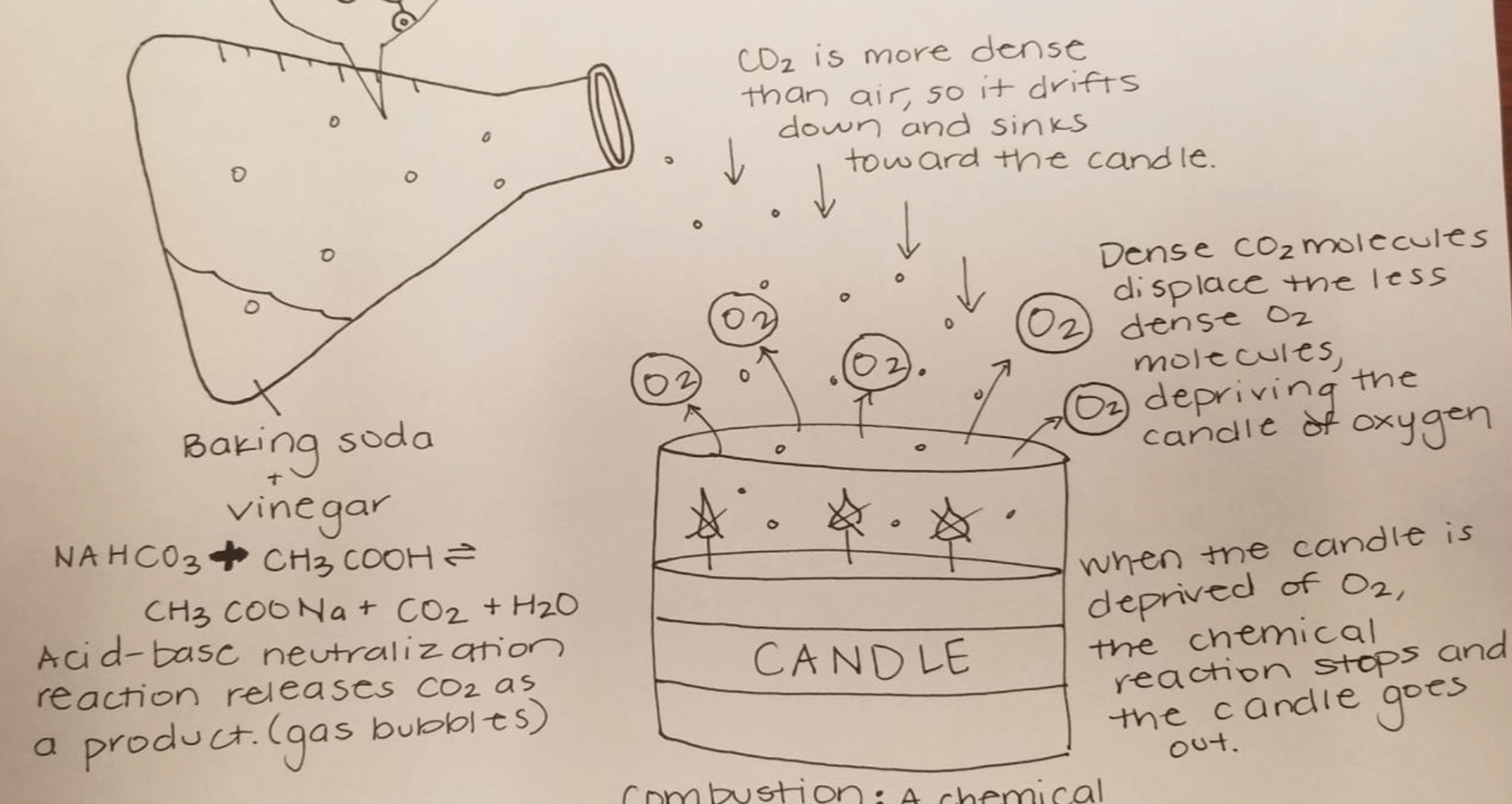
Teacher-created ideal model
The first task the students had in the unit was to create an initial model of the anchoring phenomenon, the Magic Candle Demo (see example of initial student model in Figure 3). They were given 20 minutes, chart paper, and colored markers to create their model, but no specific requirements or rubrics were provided. Students in this class were familiar with model-based inquiry and knew that a model is a pictorial or visual representation showing their understanding of the visible and invisible aspects of the phenomenon (Krajcik and Merritt 2012). Students were placed in mixed-ability groups to allow for a variety of perspectives and to challenge thinkers at all levels. These initial student models were then revisited for the two Five Practices discussions that this article focuses on. They became a tool for developing student ideas over time and allowed students to evaluate and think about their own ideas as they changed throughout the unit.
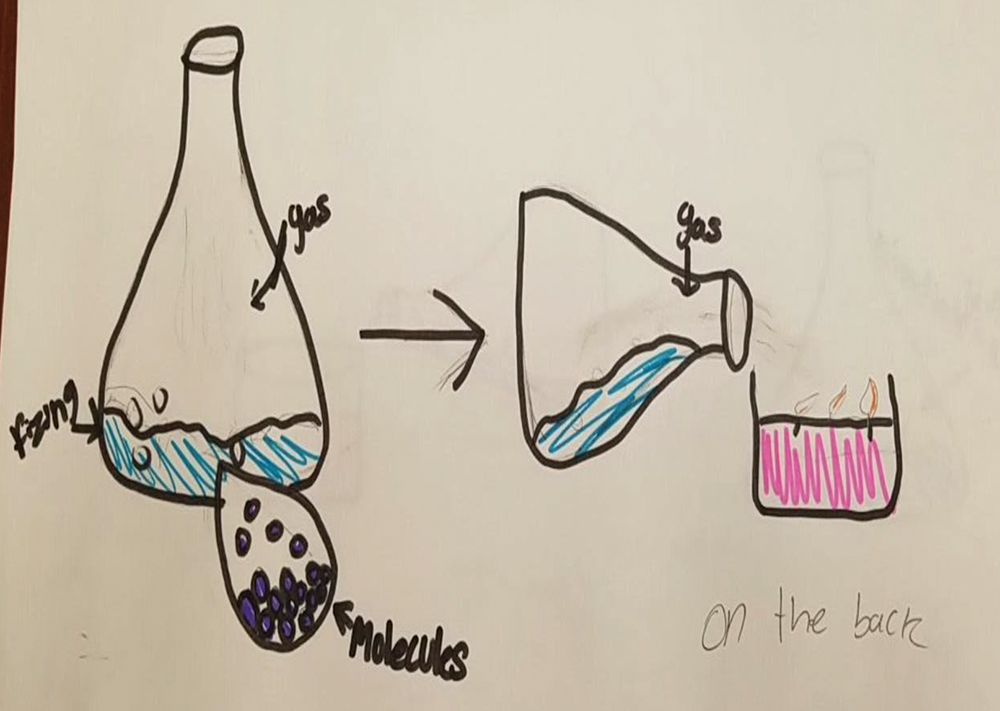
Example of initial student model
Supporting ongoing changes in student thinking
The first Five Practices discussion occurred midway through the unit. These discussions, along with the creation, revision, and finalization of student models, are checkpoints in the unit, where student ideas about the anchoring phenomenon are brought back out on the table and evaluated and discussed at different points in the learning progression of the unit. At the time of this first discussion, students had participated in several lessons and gained an understanding of physical and chemical change, compounds, molecules, mixtures, phases of matter, and density. Descriptions of the activities and investigations conducted can be found in the table summary (see Online Supplemental Materials), though the particular activities and investigations that took place are not the focus of this article. Instead, this article seeks to explain how the strategy of the Five Practices can be used to encourage the development of student ideas and metacognition before, during, and after various instructional events have taken place. The midway point was an opportune time to revisit the anchoring phenomenon and the initial models because students had learned about some of the key ideas they struggled with in their initial models. For this task, students reviewed their classmates’ initial models for about 15 minutes and provided at least five constructive comments. They were given sticky notes to do so, and the teacher modelled several examples of appropriate and constructive feedback. They then reviewed their own models and made revisions on the basis of both their own current understandings and the constructive feedback they had received. They were given 10 minutes to revise their models. Students then discussed the revisions they made to their models, as well as their reasoning. For an example of a student model with revisions and peer comments on sticky notes, see Figure 4.
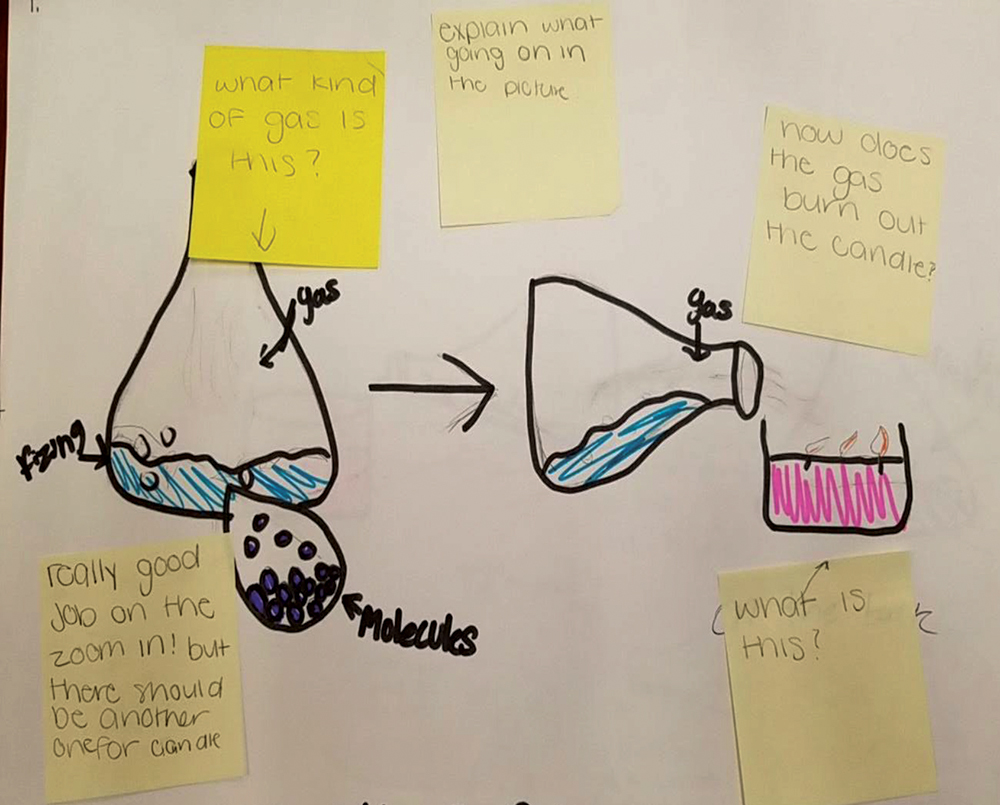
Example of revised student model with comments
In anticipating for this discussion, the teacher reviewed the initial student models and the summary table as completed thus far from the lessons. The teacher predicted that at this point in the unit, students would understand that the chemical reaction in the flask created a gas (as indicated by the bubbling in the flask when the baking soda and vinegar were mixed) and that the gas was denser than the air in the room, which would explain its tendency to “pour” when the flask was tilted over the candle. The teacher knew that students would probably still not understand the particular aspects of combustion and why the candle was extinguished by the gas, or the role of carbon dioxide in the phenomenon.
For monitoring this task, the teacher prepared “back-pocket” questions to help students provide feedback and review their peers’ work. In this case, the teacher asked questions such as “How does this model show the invisible aspects of the phenomenon?” and “Do you think this model accurately shows what is happening in the flask and in the candle?” A template of the monitoring tool can be seen in Figure 5 and can be adapted to suit any task. There are columns for the teacher to make notes of what each group added, removed, and changed on their model. These changes reflect the ongoing changes in their thinking about the phenomenon. A monitoring tool helps with both classroom management and with the development of student ideas, as it gives the teacher a guide for what to look for and how to drive student thinking forward.
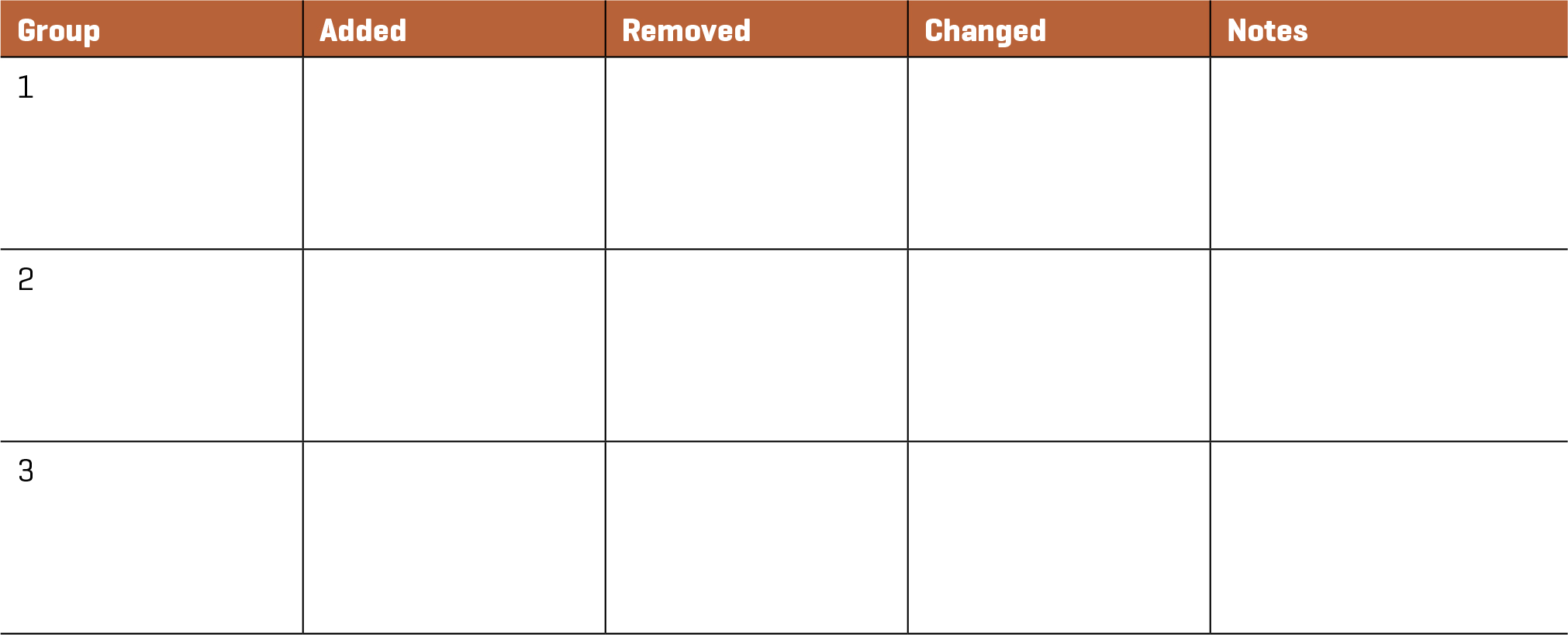
Monitoring tool: Supporting ongoing changes in student thinking
In selecting the information to be shared as a whole group, the teacher focused on observations she made about what changed the most since the initial task, because this would indicate the development of student ideas. In this case, the teacher noticed that most students had gained a strong understanding of the chemical reaction in the flask and that it created carbon dioxide gas, as well as why the gas poured. Because the purpose of this discussion was to support ongoing changes in student thinking, the selected models and group ideas that were chosen to be shared focused on the elements of the initial models that students had changed.
The sequencing phase of this discussion was planned in a storyline manner. The teacher focused on the events of the phenomenon in order. For example, she had a group share first who had revised the portion of their model that showed what was happening in the flask when the chemicals were first mixed. Then, she had a group share who had added a zoom-in bubble to the invisible gas, showing the molecules of carbon dioxide that were there but invisible. Finally, she had a group share who had added arrows showing the invisible gas pouring down out of the flask, as well as an explanation of the density of the gas as a reason for why the gas “pours” through air like a liquid.
The connecting phase aimed to get students thinking about their initial ideas and how their ideas had changed, so the connections focused on students sharing their changes in thinking. It is known that correcting student misconceptions does little to cement any changes in their thinking (Campbell, Schwarz, and Windschitl 2016). In doing a task and having a discussion such as this, student ideas are not “corrected” as wrong, but instead, students revise their own thinking and their own ideas, which is likely to result in a deeper and more permanent understanding of the concepts.
Pressing students for evidence-based explanations
The second discussion occurred on the second to last day of the unit. Students once again witnessed the phenomenon and created their final models of the phenomenon, the Magic Candle Demo. Students worked in the same mixed-ability groups that they had been in previously when constructing their initial and revised models. They were given 20 minutes to complete this task and had the completed summary table to assist them, as well as the initial/revised models they had created earlier in the unit. The purpose of this final Five Practices discussion was to press students to join together all of their ideas into a coherent representation of their understanding of the phenomenon, so that they could each individually construct an evidence-based explanation in writing.
In anticipating for this discussion, the teacher reviewed the students’ initial and revised models, as well as the summary table the class had created on the previous day. The teacher anticipated that the greatest difficulty in the final models would involve the specific chemical reactions in the model, which include a neutralization reaction in the flask and combustion in the candle. The teacher also predicted that some students would still fail to piece together exactly why the carbon dioxide gas extinguished the flame.
In the monitoring phase, the teacher used the monitoring tool created for this task (Figure 6), which incorporated all of the desired elements of the final models. Because students are expected to understand all elements of the phenomenon at this point, the monitoring tool for this discussion is more evaluative than in the previous discussion. The teacher asked students back-pocket questions, including “What was it about the carbon dioxide that caused the candle to stop burning?” and “How can we show this invisible process on the model?” Once again, the monitoring tool serves two functions—as a classroom management tool to keep students on task and progressing toward the completion of the task, and as an informative tool for the teacher to select and sequence the subsequent discussion.
Example of monitoring tool—final summative model
|
Group |
Correctly represented |
Incorrect/missing explanation |
Order/Notes |
|
1 |
__ Neutralization reaction __ Production of CO2 gas __ CO2 gas density __ Combustion reaction __ Displacement of O2 by CO2 __ Shows molecular activity __ Chemical equations |
__ Neutralization reaction __ Production of CO2 gas __ CO2 gas density __ Combustion reaction __ Displacement of O2 by CO2 __ Shows molecular activity __ Chemical equations |
|
In selecting for this discussion, the teacher chose groups highlighting common issues seen throughout many of the models. Some things she noticed were a lack of the specific names of the chemical reactions and a lack of showing the invisible molecules involved in the combustion and extinguishment of the candle. As before, not every group was selected to present, but all groups were expected to participate in the discussion. The selection process is invisible to the students, that is, the process occurs internally by the teacher.
The teacher approached the sequencing phase differently than the previous Five Practices discussion. The teacher decided to utilize a strategy that built understanding by showing the models that illustrated the least-desired elements present in the model to the most desired elements. Sequencing the discussion in this way allowed for the group consensus understanding to build and develop, driven by the students’ thoughts and ideas being shared. Again, this process is invisible—students don’t know if their model was selected because it had the least or most desired elements. See Figure 7 for an example of a final model that was shared in this discussion.
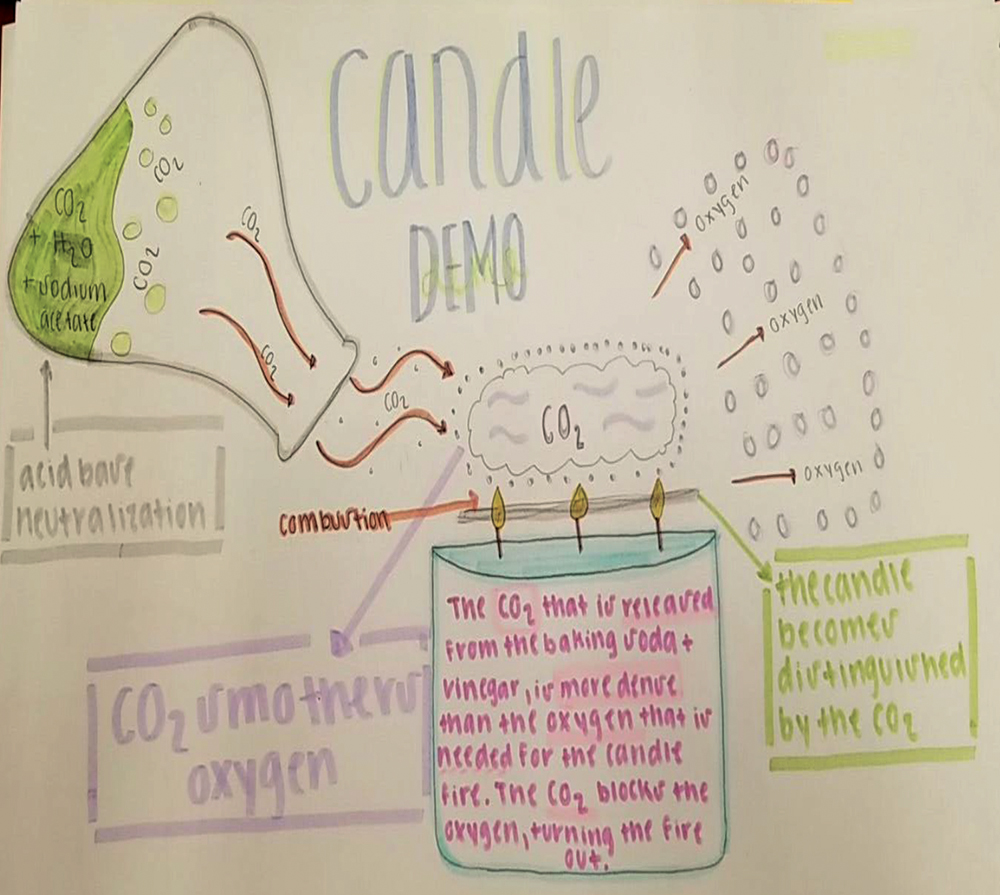
Example of final summative model
Finally, in connecting the students’ presentations and ideas, the teacher guided students toward identifying the important elements of the model. Not every group correctly identified all of the elements in the phenomenon, nor is that necessary at this stage. At the conclusion of the discussion, students made final notes in their summary tables and final models in preparation for writing their final evidence-based explanations the following day. The student models were assessed using the initial teacher-created benchmark model seen earlier in Figure 2. The final models created by the work and ongoing discourse of the student groups became a tool to assist them in writing their final evidence-based explanations, which is not the focus of this article.
As can be seen in the sample student final model in Figure 7, students uncovered many of the important aspects of this phenomenon through their investigations and discussions. In the flask, CO2 is shown being released by the acid-base neutralization reaction of vinegar and baking soda. This demonstrates an understanding that the molecules involved in the reaction are being rearranged. The CO2 is then shown displacing the oxygen that feeds the combustion reaction of the candle, thereby extinguishing the flame.
Ultimately, this unit concluded with students constructing evidence-based explanations of the anchoring phenomenon. These written explanations would not have been possible without purposeful, guided instruction, investigations, and discourse opportunities that were planned and designed with the principles of ambitious science teaching in mind. The real “meaning-making” occurred through student conversations, which took place periodically but purposefully during the unit. The Five Practices served as the tool to develop student ideas in these conversations and is versatile enough to allow teachers to facilitate meaningful discussions around rigorous tasks with a variety of goals in mind.
Danielle K. Ross (dross1225@gmail.com) was formerly an assistant professor of science education at Northern Arizona University in Flagstaff. She is currently faculty at the Chesapeake Bay Governor’s School for Marine and Environmental Science in Virginia. Allison Davidson is a middle school science teacher in Phoenix, Arizona.
Inquiry NGSS Phenomena Middle School



